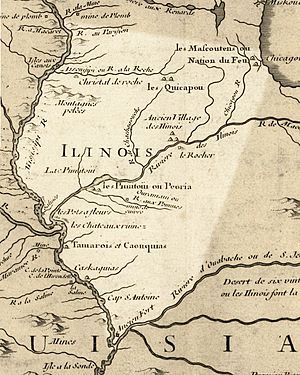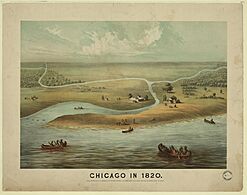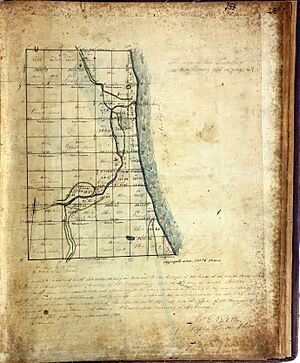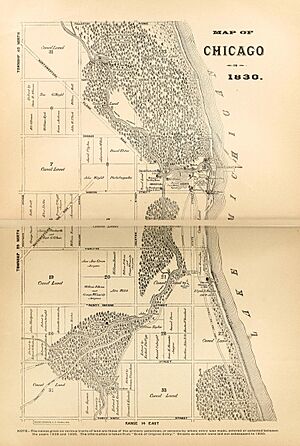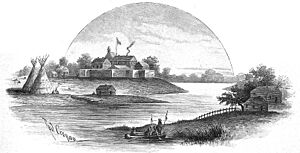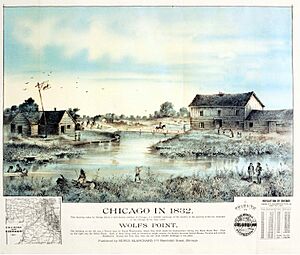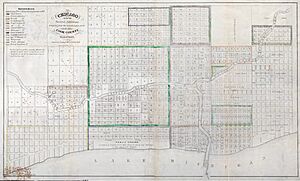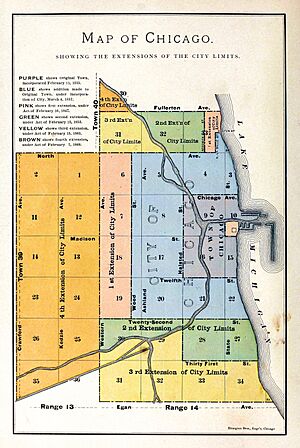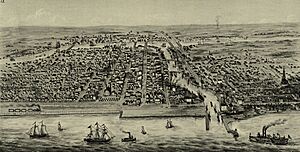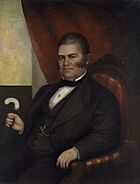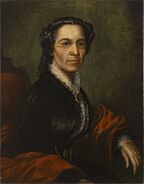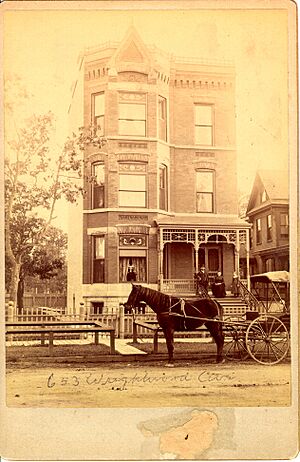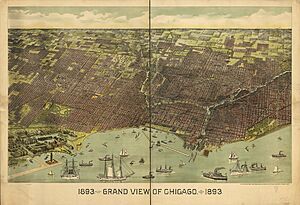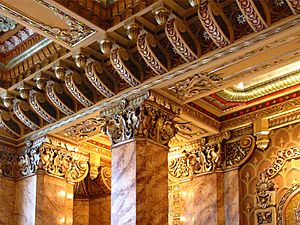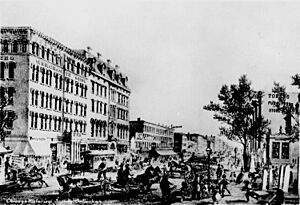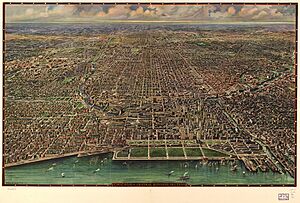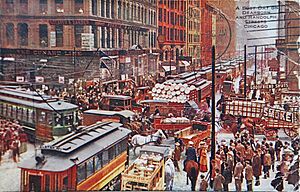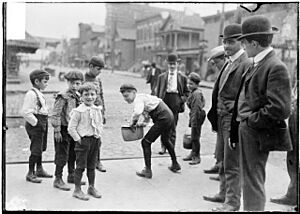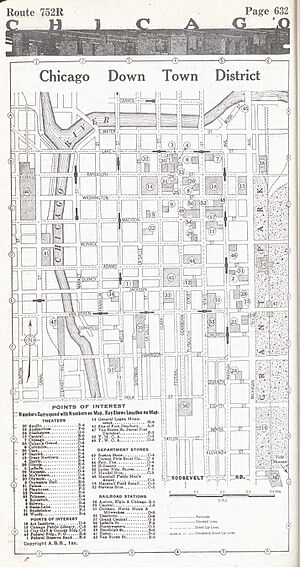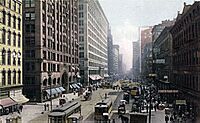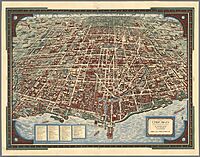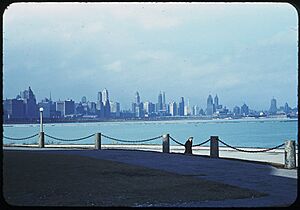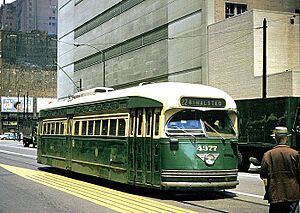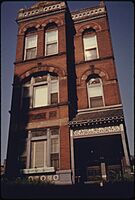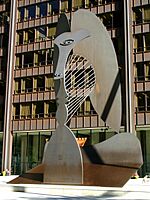History of Chicago facts for kids
Chicago has played a very important part in American history. It has been a major city in the Midwest since the 1850s. It became the largest city in the Midwest by 1880.
The story of Chicago began with French explorers and traders. They arrived in the late 1600s. They met the local Pottawatomie Native Americans. Jean Baptiste Point du Sable was the first non-Native American settler. He built a house near the Chicago River in the late 1700s.
Small settlements and a U.S. Army fort were built. But soldiers and settlers were forced out in 1812. The modern city of Chicago was officially started in 1837. It grew quickly because of land sales. It was also a great spot for transportation. It connected the Great Lakes to the Mississippi River by canals and railroads.
A huge fire in 1871 destroyed the city's main business area. But Chicago grew even faster after that. It became the nation's main rail center. It was also a top spot for factories, trade, and money. Chicago was also known for its colleges, churches, and media. It became famous for jazz music and other arts.
Many people from Europe moved to Chicago. First came Germans, Irish, and Scandinavians. Later, from the 1890s to 1914, came Jews, Czechs, Poles, and Italians. They all became part of the city's strong political system. Many joined powerful labor unions. Chicago became known for its high wages. But it also had some violent strikes.
Many African Americans moved from the South. This was part of the Great Migration around World War I. Mexicans started arriving after 1910. Puerto Ricans came after 1945. The suburbs around Cook County grew fast after 1945.
After 1970, many factories closed. But Chicago remained a major center for money and transportation. It focused more on services like medicine, education, and tourism. Important leaders like Stephen A. Douglas, Adlai Stevenson, and Barack Obama came from Chicago.
Early History (Before 1830)
Native American Settlements
When explorers first arrived, the Chicago area was home to Algonquian peoples. These included the Mascouten and Miami tribes. The name "Chicago" comes from a Native American word. It means "wild garlic" because a lot of it grew here.
The first mention of "Checagou" was around 1679. This was by Robert de LaSalle. Another explorer, Henri Joutel, wrote in 1688 about the wild garlic. He said the area was named for the "quantity of garlic which grows in the forests."
Chicago's location was very important. It had a short canoe path called the Chicago Portage. This path connected the Great Lakes to the Mississippi River system. Many French explorers, like Louis Jolliet and Jacques Marquette, noticed this in 1673.
French missionaries built the Mission of the Guardian Angel in 1696. They wanted to teach Christianity to the local Miami people. Later, the Potawatomi tribe took control of the area. But they probably did not have large settlements in Chicago.
First Non-Native Settlers
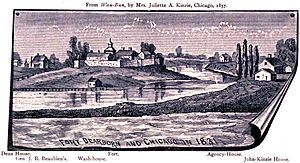
The first non-Native American settler in Chicago was Jean Baptiste Point du Sable. He was of French and African descent. He built a farm near the Chicago River around 1788 to 1790. He left Chicago in 1800. Today, Point du Sable is honored as the city's founder.
In 1795, Native Americans gave the Chicago area to the United States. This was for a military post. The U.S. built Fort Dearborn in 1803 on the Chicago River. During the War of 1812, Native American forces destroyed the fort. Many people were killed or captured.
After the war, the Potawatomi gave the land to the U.S. in 1816. Fort Dearborn was rebuilt in 1818. It was used until 1837.
City Growth
In 1829, Illinois leaders decided to plan a canal. They also planned the town around it. James Thompson surveyed and mapped the town of Chicago. At that time, fewer than 100 people lived there. The official map was filed on August 4, 1830. This is seen as the official start of Chicago.
Business people saw Chicago's potential as a transportation center. They bought land in the 1830s. On August 12, 1833, the Town of Chicago was formed. It had 350 people. In 1833, the Chippewa, Odawa, and Potawatomi tribes gave up their land. They were forced to move west of the Mississippi River.
On March 4, 1837, Chicago became an official city. By 1840, its population had grown to over 4,000. The rich farmlands nearby attracted many settlers. Roads were built to help farmers bring their crops to Chicago. This allowed grain and other goods to be shipped east through the Great Lakes.
In 1837, Chicago held its first election for mayor. William B. Ogden became the first mayor.
Becoming a Transportation Center
In 1848, the Illinois and Michigan Canal opened. This allowed ships to travel from the Great Lakes through Chicago. They could then reach the Mississippi River and the Gulf of Mexico. The first railroad line to Chicago also opened that year. Chicago quickly became a major transportation hub for the United States. It had connections by road, rail, water, and later, air.
By the 1850s, over 30 railroad lines came into Chicago. The city became a center for shipping and storage. Factories were built, like the McCormick harvester factory in 1847. Chicago processed natural resources from the West. Forests in Wisconsin provided lumber. Illinois farms provided wheat. Thousands of hogs and cattle were sent to Chicago for processing. By 1870, refrigerated cars allowed fresh meat to be shipped.
The area around Chicago was often muddy. It was so muddy that horses could barely move. The city was known for being very dirty. So, Chicago built a huge sewer system. In 1856, the city decided to raise the entire city. They lifted buildings four to five feet using a special jacking process. One hotel, weighing 22,000 tons, was lifted while still open for business! This showed how determined and clever Americans were.
Immigration and Population in the 1800s

In the 1840s, many Irish Catholics came to Chicago. They were escaping the Great Famine in Ireland. Later, railroads and factories attracted skilled workers from Europe. These included Germans, English, Swedes, and Norwegians. A small African-American community also formed. Leaders like John Jones and Mary Richardson Jones helped make Chicago a stop on the Underground Railroad.
In 1840, Chicago was the 92nd largest city in the U.S. Twenty years later, it was the ninth largest. By 1857, Chicago was the biggest city in the Midwest. Its population grew from 4,000 to over 90,000 in just 20 years. Chicago became a politically important city. It was home to Stephen Douglas and where Abraham Lincoln was nominated for president in 1860.
Many new people were Irish Catholic and German immigrants. Their neighborhood saloons were social centers for men. In the 1850s, a group called the Know-Nothing Party tried to ban Sunday liquor sales. This led to a riot in 1855. After 1865, saloons became important community places for different ethnic groups.
By 1870, Chicago was the nation's second-largest city. It was one of the fastest-growing cities in the world. Between 1870 and 1900, Chicago's population grew from 299,000 to nearly 1.7 million. This amazing growth brought many new immigrants from Eastern and Central Europe. These included Jews, Poles, and Italians.
The Gilded Age
Most of Chicago burned in the 1871 Great Chicago Fire. About 300 people died. 18,000 buildings were destroyed. Nearly 100,000 people lost their homes. Most buildings and sidewalks were made of wood. Also, there was a lot of flammable waste in the Chicago River. This helped the fire spread. After the fire, strict fire-safety rules were made. Buildings had to be made of stone or brick.
The World's Columbian Exposition was held in 1893. It was built on former wetlands near Lake Michigan. The fair was designed by famous architects. It was called the "White City" because of its buildings.
The Exposition had 27.5 million visitors. It greatly influenced art, architecture, and design across the country. The fair also featured the first and largest Ferris wheel.
The soft ground near the lake made it hard to build tall buildings. But builders found a new way. They used steel frames for support. This led to the invention of the skyscraper in Chicago. Chicago became a leader in modern architecture.
The city was quickly rebuilt. New materials and methods were used. This helped Chicago become a major city, like New York. It also became the birthplace of modern architecture in the United States.
Rise of Industry and Business

Chicago became a major center for advertising. Albert Lasker is known as the "father of modern advertising." He worked in Chicago from 1898 to 1942. He created new ways to advertise. He used psychology to appeal to customers. For example, he told women that smoking Lucky Strikes could help them stay thin. Lasker's use of radio changed advertising. It also changed popular culture.
20th Century
Chicago's factories and stores grew fast. They were helped by the expansion of railroads. Chicago became a major force in the Midwest economy. The Chicago Union Stock Yards became very important for meatpacking. Chicago became the world's largest rail hub. It was also one of the busiest ports on the Great Lakes.
Lake Michigan was the city's main source of fresh water. But it became polluted by growing industries. So, a new way to get clean water was needed. In 1885, an engineer named Lyman Edgar Cooley suggested building the Chicago Sanitary and Ship Canal. This canal would take water from Lake Michigan. It would then send the city's waste into the Illinois River. This river flows into the Mississippi River.
The canal also helped connect the Midwest to America's central waterways. This helped Chicago compete with East Coast shipping. The canal opened in January 1900. In 1929, the U.S. Supreme Court allowed Chicago to use the canal for trade. But it ordered the city to stop using it for sewage.
New buildings were built a lot in the 1920s. Famous ones include the Merchandise Mart. The art deco Chicago Board of Trade Building was finished in 1930. But the Wall Street Crash of 1929 and the Great Depression stopped new construction for years.
The Century of Progress International Exposition was a World's Fair. It was held from 1933 to 1934. It celebrated Chicago's 100th birthday. The fair showed off new technology. Over 40 million people visited the fair. It gave hope to many during the Great Depression.
The city's population was changing. Many black families from the South moved north. Black children faced challenges in getting help from institutions. Between 1899 and 1945, many black children ended up in the juvenile court system. A law in 1899 aimed to help children without proper care. But black children were more likely to be labeled as "delinquents."
Politics in the Early 1900s
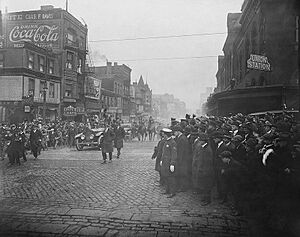
In 1875, Chicago voters chose to follow the Illinois Cities and Villages Act of 1872. Chicago still uses this act today.
Newspapers like the Chicago Daily News became very popular. They reported on community life and city problems. Competition was strong between newspapers. Chicago's politicians and lobbyists earned the city the nickname "Windy City." This name came from the New York press. The city later adopted the nickname.
-
State Street around 1907.
-
Oak Street Beach, 1925.
Labor Unions
After 1900, Chicago had many labor unions. The Industrial Workers of the World was founded in Chicago in 1905. Railroad unions and craft unions were strong. They worked together to avoid conflicts.
Teamsters (people who drove wagons) had a lot of power. Their wagons could block streets. This helped them during strikes. They also had strong support from their neighborhoods. When teamsters went on sympathy strikes, employers tried to stop them. Employers saw streets as ways for business. Teamsters saw them as public spaces for their communities.
World War II
On December 2, 1942, the world's first controlled nuclear reaction happened. This was at the University of Chicago. It was part of the secret Manhattan Project.
During World War II, Chicago's steel mills made a huge amount of steel. They produced 20% of all U.S. steel. The city made more steel than the United Kingdom during the war.
Chicago's many industries made it second only to Detroit in war goods produced. Over 1,400 companies made everything from food to torpedoes. New aircraft plants employed 100,000 people. The Great Migration of black Americans continued. Hundreds of thousands came to Chicago for jobs. They worked in steel mills, railroads, and shipping yards.
After the War
After World War II, returning soldiers and immigrants created an economic boom. This led to many new housing developments. Chicago was photographed a lot by street photographers like Richard Nickel and Vivian Maier.
In the 1950s, many middle and upper-income people moved to the suburbs. They wanted new homes and better schools. Changes in industries like meatpacking and steel led to many job losses. Chicago's population shrank by almost 700,000 people.
The city council created "Plan 21." This plan aimed to improve neighborhoods. It focused on creating "suburbs within the city" near downtown. It also built public housing. But this sometimes moved poor people from their homes. Civil rights laws in the 1960s also affected Chicago. Many people continued to move to the suburbs.
Office building construction started again in the 1960s. The Sears Tower, now the Willis Tower, was finished in 1974. At 1451 feet, it was the world's tallest building. It was designed by a famous Chicago firm.
-
Chicago Picasso, a 1967 sculpture in Daley Plaza.
Mayor Richard J. Daley served from 1955 to 1976. He was very powerful in the city's politics. He helped build major expressways and O'Hare Airport. O'Hare became the world's busiest airport. Some neighborhoods near downtown were improved. They became like "suburbs within the city."
Daley was mayor during the unrest of the 1960s. After the assassination of Martin Luther King Jr. in 1968, major riots happened. Parts of black neighborhoods were burned. Protests against the Vietnam War happened at the 1968 Democratic National Convention in Chicago. This led to street violence.
In 1979, Jane Byrne became Chicago's first woman mayor. In 1983, Harold Washington became the first black mayor. Richard M. Daley, son of Richard J. Daley, became mayor in 1989. He was reelected many times. He tore down many large public housing projects. These projects had become run-down. New housing projects are now designed to be better and safer.
21st Century
Chicago was named "City of the Year" in 2008 by GQ. This was for its architecture, literature, politics, and its role in the Batman movie The Dark Knight. Moody's rated Chicago as having a very balanced economy. This is because it has many different types of businesses.
Flag
The Flag of Chicago has four red stars. They represent four important historical events:
- Fort Dearborn, built in 1803.
- The Great Chicago Fire of 1871.
- The World Columbian Exposition of 1893.
- The Century of Progress World's Fair of 1933–1934.
The flag's two blue stripes show the north and south branches of the Chicago River. This river flows through the city's downtown. The three white stripes represent the North, West, and South sides of the city. Lake Michigan is on the east side.
See also
- American urban history
- Bibliography of Chicago history
- Chicago in the 1930s
- Ethnic groups in Chicago; the larger groups have articles such as Poles in Chicago and History of African Americans in Chicago
- History of education in Chicago
- Political history of Chicago
- Roman Catholic Archdiocese of Chicago
- Timeline of Chicago history


